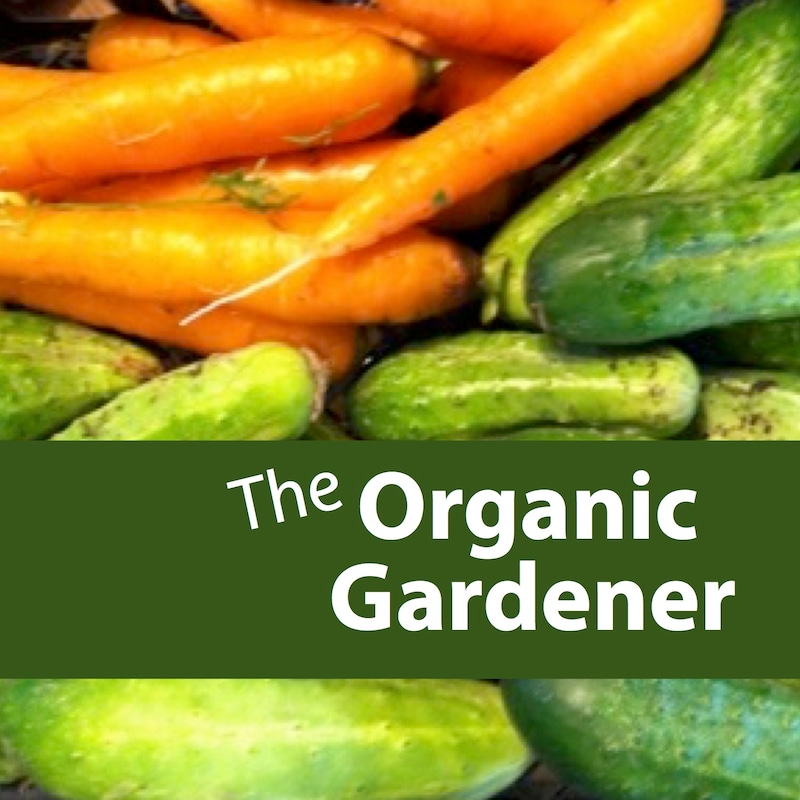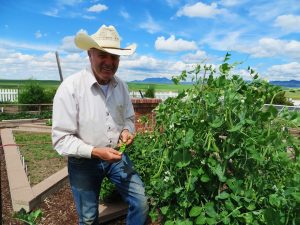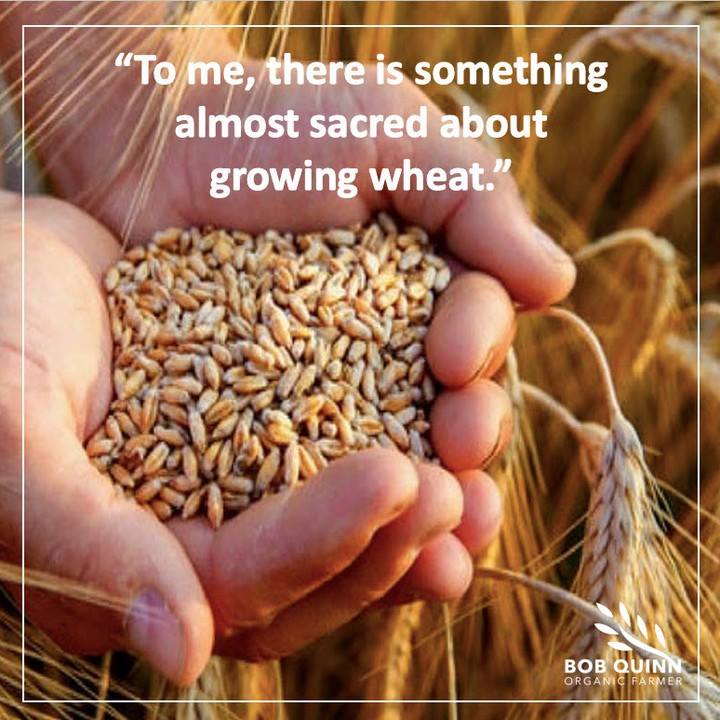
Shownotes
Today I am so excited to introduce my guest Bob Quinn who is back to tell us about his new book
Grain by Grain: A Quest to Revive Ancient Wheat, Rural Jobs, and Healthy Food
You can read the Golden Seeds Issue #7 here if you prefer!
Here’s my 5 star review, make sure you write yours!

Thanks so much for sending me your book, you were worried if I would be able to read it and then I whipped through it in under 48 hours was so engaging!

Thanks Jackie!
It was a lot of fun to write with Liz who is a great partner who made the story easy to read. She was able to keep it free flowing from one topic to another.
There’s so many things to discuss, it’s a bit of a challenge to meet the limitations that they place on us from keeping the book from being a gone with the wind version with so many topics.
We tried to hit the highlights of subjects I’m passionate of
- The High Cost Cheap Food
- Decline of Rural America and the
- Disappearance of Our Farms
all because we have been encouraged to look at our farms like factories and industrial agriculture food systems.
I love the relationships you build and people you talk to. I love biographies, I’ve had a lot of time to read this year, I’ve been to the library a lot this year!
Along with Liz Carlisle author of the Lentil Undergound
Why don’t you tell listeners a little about yourself?
Well I was raised on a wheat and cattle ranch in Big Sandy about 12 miles out of town. Near Havre Great Falls. It’s South of Canadian border where Alberta and Saskatchewan meet. My father was raised here and I started after him and now I raised my children so 3 generations ~
I don’t see any of my children coming back. I have 18 grandkids, maybe one of them. I leased out my farm to a couple of my employees, that I have trained.
I had a great time! I had my turn in farming! It was fantastic now it’s time for the next generation to learn! I’ve gone from 4000 acres down to 4 acres. I continue some of my experiments throughout my life and try to grow all my own food:
- dry-land vegetables
- grow melons drylands
- storage
- non storage like tomatoes
in a field with no irrigation which is a total challenge.
We’re sort of like that here, my husband grew up on a 1200 acre ranch and we have the last 20 acres and we have very limited water. You’re such a scientist and talk about how you try 40 lbs of potatoes and narrow it down to five.
If we look at food as a health component and they have different criteria to add to that there are all kinds of things we can learn. with different types of food. What we have looked at in recent years is the cost of food and making it cheap and high yielding in order to have it cheap.
High cost to the Cheap Food
Starts with the farmers aren’t paid enough to stay in business and make a living
consumer
artificially cheap food at the check out counter
That’s only the first parts of it. I’m interested in teaching people
food should be ear health and medicine and medicine should be your food. If we could reduce the cost of medicine and health care while food has decreased in price.
The cost of food in the average budget has decreased 61% while the extra money we saved on health care we didn’t get to spend it on boats etc the cost of health care has increased 61% and those are astounding statistics!
what we have done to make food cheap.
Is it true in drylands farming something new farmers would be interested in. They’re not getting watered down so they increase in nutrient value?
Reduce Inflammation
I’ve compared tomatoes I’m raising tomatoes in my field with no irrigation side by side, the flavor intensity in the drylands tomatoes is really noticeable
what makes
secondary
polyphenols are very strong antioxidants attributed to reducing inflammation
choosing higher nutrition in almost aliases vegetables and foods by their aromas
one criteria
one thing we notice in drylands
organic non-organic
People often comment on the intensity of the flavor and that’s what were seeing which is connected with health.
There’s no way they could grow dry-land vegetables non-organically could they?
I suppose but the value of non-organic
People are willing to pay more and they’re higher value and so they’re actually getting more for they money.
What we do is give those vegetables about 3xs more space then you would normally do in an irrigated field or in places like the midwest where they don’t even water their lawns
density
vegetable
3 times more space then they normally receive
produce and each plant will produce as much as an irrigated.
1/3 per many per acre but we have lots of acres so that’s not a problem. Really reducing the cost of our farming except the labor to control weeds.
But the cost of inputs like water is just nil.
That makes sense because clean water is becoming more scarce, and so people might want to learn about this drylands farming. I feel like if we were practicing more of these practices we wouldn’t see so many fires and smoke in summers.
We are seeing that on our own farm. There’s no time to debate about climate change farmers need to respond to it. What we see, generally, what we see are the rains are ending sooner and the heat is coming sooner. So our spring crops are becoming higher and higher risk. One thing we’re trying is planting traditional spring crops in the fall so they can get through the winter and benefit from early spring rains and start maturing before the heat really hits.
Yeah this year we still have 2-3 feet of snow in our yard and 2 weeks ago we were below 0º at the beginning of March.
It’s not really correct to just refer to climate changes as global warming per say. Although the glaciers are melting in Glacier Park and also in the ice caps.
What we are seeing more of are the extremes.
A few years ago we went from the extreme a high amount of rain that we would normally have on the top of the rain cycles to the very next year was an extreme drought which would normally be at the other end of the cycle and 5-6 years off.
And you are definitely the data man to know all that kind of thing.
Grain by Grain: A Quest to Revive Ancient Wheat, Rural Jobs, and Healthy Food
What do you want to tell us about our book?
I’ve seen a lot of people write a lot of books to tell their story. I spent 5 years trying to put something together that would be the story of our
- KAMUT® story and
- ancient wheat story and what I have
- learned in organic agriculture
- importance of food as medicine
- lots of these different things I have learned along the way.
I didn’t have any luck finding a publisher.
Finally I bumped into Liz Carlisle, author of the Lentil Underground who is from Montana we bumped into at that field day and many of the people in the book she wrote about we were having reunion and I asked her if she would partner with me.
The bigger story is what we have done to our food system.
So we dive into the high cost of things:
- the high cost of cheap food
- the high cost of farmers the high cost of going out of business
- farmers who went out of business
- next high cost to our planet
global climate change ~ a vehicle to tell the bigger story
- My listeners are always interested in learning what they can do to be more productive and better farmers and I’m sure many of them are wondering how can they become a Kamut farmer, I know one thing I am interested in is the hemp project and how is that coming along?
Montana Hemp Farming Project
Well, for us a little bit slow we started out with 7 acres that took us 2 years to sell that crop. I always caution my friends to be sure you have a market before you sell it.
That’s interesting because there’s actually a big CBD plant here in Eureka and they were saying they couldn’t get their hands on enough hemp and had to start their own farm in Shelby kind of near you.
Well now CBD that’s a different product then we were growing. We were just growing the industrial plant for the seed and with the CBD oil you have to harvest the plant green and then you extract the CBD oil with alcohol. So it’s a completely different process then waiting for the plants to mature and gather the seeds so that you harvest the mature plant for seeds and we were crushing those seeds for oil. Cut and bail your hemp crop as it’s quite immature just as it’s beginning to flower you have to know what’s your market.
Industrial Hemp
We were involved in distributing industrial hemp this spring. Maybe a 100, couple of thousand acres. I don’t know if they were sure they knew where they were going to sell that product.
I was thinking you were so good at making connections and building relationships and I love that picture of you and your parents at the farm show in California and how you were willing to get out there and find markets and talk to people, starting out with your Kamut and have just gone on from there.
Well you mentioned a story about not everybody gets to be a farmer but I like to remind folks if you are eating, you’re actually a co-producer. As Carlo Petrini in the slow food movement in Italy if you are not a farmer but eat you are a coproducer
That’s a connection not often thought about but very important.
The eaters in this country are really in the drivers seat!
what they order at restaurant
what they eat at home
really drives what the farmers are planting

That’s the vast majority of farmers now only about 1%. So we’re looking at the 99%
If they want a regenerative organic agriculture and renewable systems that don’t pollute the earth we have to grow food more that’s actually nutritious all they need to do is buy more organic food
All they need to do is just buy one additional product then you did the last time that will begin to make an enormous difference!
But isn’t that part of what you re talking about, I can’t afford to buy organic food a lot of the time. I’m lucky Mike grows for me a lot of organic food.
Just one more organic item
If your at 0 buy one more item.
Those incremental differences don’t make that big of a difference on your bottom line. If you are on a reduced budget just buy things that are less processed and therefore less expensive.
Our KAMUT® brand grain is a very expensive grain, it costs a couple of dollars a pound were to buy the it in the store. But if you were to buy that and take it home and crack it and make hot cereal you could feed a family of four for less then 50¢, so it’s not a big cost.
So if you look at the drivers if we start increasing the amount of organic available the transportation and handling costs will start to come down the more we have available and it becomes less of a specialty item.
Do you want to talk about your fruit trees and 4 acres you are gardening on now?
Sure, I also like to experiment with what else can we do in the prairies of northern Montana besides wheat and barley. One thing I have been experimenting with for 10 years is fruit trees. We have about
- 21 different varieties of apples
- pears
- plums
- sour cherries
- fruit bushes
We can’t grow sweet cherries here but we can grow sour cherries.
I have about 20 different types of native berry bushes.
All the way from:
- seed buckthorn from Siberia
- buffalo berries
- currants
- chokecherries
- service berries that are native berries available here in the coolies on our farm. We want to see what berries grow best.
We grow grapes!
Some varieties my daughter is making red wine vinegar out of the grapes and sour cherries which is just fantastic!





